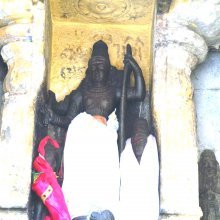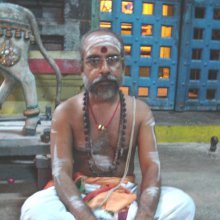Yuga: 35 definitions
Introduction:
Yuga means something in Buddhism, Pali, Hinduism, Sanskrit, the history of ancient India, Marathi, Hindi. If you want to know the exact meaning, history, etymology or English translation of this term then check out the descriptions on this page. Add your comment or reference to a book if you want to contribute to this summary article.
Images (photo gallery)
(+2 more images available)
In Hinduism
Vaishnavism (Vaishava dharma)
Source: Manblunder: Viṣṇu-sahasranāma > detail pageThere are four yuga's, 1. Kṛta or Satya, 2. Tretā, 3. Dvāpara, 4. Kali, of which the first three have already elapsed, while the Kali, which began at midnight between the 17th and 18th of Feb. 3102 BC. The duration of each yuga is said to be respectively 1,728,000, 1,296,000, 864,000, and 432,000 years of humanity, the descending numbers representing a similar physical and moral deterioration of men in each age. (excerpt from nāma 154)
Source: Pure Bhakti: Bhagavad-gita (4th edition)Yuga (युग) refers to “one age within the cycle of the universal four ages, named Satya, Tretā, Dvāpara and Kali”. (cf. Glossary page from Śrīmad-Bhagavad-Gītā).
Source: Pure Bhakti: Bhajana-rahasya - 2nd EditionYuga (युग) refers to:—One of the four ages described in the Vedas: Satya-yuga, Tretā-yuga, Dvāpara-yuga and Kali-yuga. (cf. Glossary page from Bhajana-Rahasya).
Source: Prabhupada Books: Sri Caitanya CaritamrtaYuga (युग) or Yugāvatāra refers to “incarnations in different millenniums”, according to the Śrī Caitanya Caritāmṛta 2.20.246 (“The Science of the Absolute Truth”).—Accordingly, “There are incarnations that control the material qualities [guṇa-avatāras], incarnations who appear during the reign of each Manu [manvantara-avatāras], incarnations in different millenniums [yuga-avatāras] and incarnations of empowered living entities [śaktyāveśa-avatāras]”.

Vaishnava (वैष्णव, vaiṣṇava) or vaishnavism (vaiṣṇavism) represents a tradition of Hinduism worshipping Vishnu as the supreme Lord. Similar to the Shaktism and Shaivism traditions, Vaishnavism also developed as an individual movement, famous for its exposition of the dashavatara (‘ten avatars of Vishnu’).
Dharmashastra (religious law)
Source: Wisdom Library: Dharma-śāstraYuga (युग) is a Sanskrit technical term referring a “piece of wooden pole”, of a chariot (yāna). The word is used throughout Dharmaśāstra literature such as the Manusmṛti. (See the Manubhāṣya, verse 8.291-292)

Dharmashastra (धर्मशास्त्र, dharmaśāstra) contains the instructions (shastra) regarding religious conduct of livelihood (dharma), ceremonies, jurisprudence (study of law) and more. It is categorized as smriti, an important and authoritative selection of books dealing with the Hindu lifestyle.
Purana and Itihasa (epic history)
Source: archive.org: Puranic EncyclopediaYuga (युग).—See under Manvantara.
Source: archive.org: Shiva Purana - English TranslationYuga (युग) refers to the “shafts” (of a chariot), according to the Śivapurāṇa 2.5.8 (“The detailed description of the chariot etc.”).—Accordingly, as Sanatkumāra narrated to Vyāsa: “The divine chariot of lord Śiva consisting of all the worlds was built by Viśvakarman with devoted effort. [...] The firmament constituted the fender of the chariot; Heaven and salvation the flag staffs; Abhṛamu (Abhramu?) and Kāmadhenu constituted its harrows at the end of the shafts (yuga-anta) [yugāntakoṭitau tasya bhramakāmadughau smṛtau]. The unmanifest principle formed their shaft and cosmic intellect the chariot’s reeds. The cosmic Ego cosmic corners and elements its strength. [...]”.
Source: Cologne Digital Sanskrit Dictionaries: The Purana Index1a) Yuga (युग).—The intervening time between one yuga-sandhyapūrva and sandhyāṃśa; four in number; Kṛta, Treta, Dvāpara and Kali. The extent is of 12,000 years of celestial measure; the duration of the yugas includes sandhya, 12,000 divine years, 1,000 caturyugas make a day of Brahmā.1 A yugam of five years, commencing with śravaṇa and ending with dhaniṣṭhā nakṣatra—the five years are respectively Agni, Sūrya, Soma, Vāyu and Rudra; consists of Samvatsara, Parivatsara, Idvatsara, Anuvatsara and Vatsara; revolves like the wheel owing to the movement of the Sun.2 Social conditions in;3 of Śaptaṛṣis.4
- 1) Bhāgavata-purāṇa II. 8. 17; III. 11. 18; XII. Ch. 4 (whole) ; Vāyu-purāṇa 7. 22; 23. 83; 24. 1; 31. 21; Viṣṇu-purāṇa I. 3. 11-15.
- 2) Brahmāṇḍa-purāṇa II. 13. 115, 147; 21. 131; 24. 57 and 144; 28. 22; Vāyu-purāṇa 31. 28, 49; 32. 57-65; 50. 182; 53. 116; 56. 21; Viṣṇu-purāṇa II. 8. 72.
- 3) Matsya-purāṇa Ch. 165.
- 4) Vāyu-purāṇa 99. 419.
1b) A measurement equal to four hastas or dhanus; equal to a dhanurdaṇḍa.*
- * Brahmāṇḍa-purāṇa II. 7. 100; Vāyu-purāṇa 8. 106; 101. 125.

The Purana (पुराण, purāṇas) refers to Sanskrit literature preserving ancient India’s vast cultural history, including historical legends, religious ceremonies, various arts and sciences. The eighteen mahapuranas total over 400,000 shlokas (metrical couplets) and date to at least several centuries BCE.
Jyotisha (astronomy and astrology)
Source: Wisdom Library: Brihat Samhita by Varahamihira1) Yuga (युग) refers to 43,20,000 Solar years, according to the Bṛhatsaṃhitā (chapter 2), an encyclopedic Sanskrit work written by Varāhamihira mainly focusing on the science of ancient Indian astronomy astronomy (Jyotiṣa).—Accordingly, “We shall now proceed to give a brief description of (the qualifications of) a jyotiṣaka. [...] He must have a correct, knowledge of a yuga (43,20,000 Solar years), varṣa (a solar year), āyana (6 solar months), ṛtu (2 solar months), māsa (a solar month), pakṣa (15 solar days), ahorātra (a solar day), yama (one-eighth of a solar day), muhūrta (one-thirtieth of a solar day), nāḍī (one-sixtieth of a solar day or 24 minutes), vināḍi (one sixtieth of a nāḍī or 24 seconds), prāṇa (4 seconds) truṭi (33, 75th of a second) and parts of a truṭi and other divisions of time and also of divisions of space”.
2) Yuga (युग) refers to a “period of five years”, according to the Bṛhatsaṃhitā (chapter 2).—Accordingly, “We shall now proceed to give a brief description of (the qualifications of) a jyotiṣaka. [...] He must have a clear knowledge of the causes of Solar, Savana, Siderial and Lunar months as well as of intercalary lunations and intercalary days [i.e., avama]. He must have a knowledge of the beginning and end of Śaṣṭyābda (a cycle of 60 years) [Ṣaṣṭyabda?], a Yuga (5 years), Varṣa (a year), Māsa (a month), Thina (a day) and Horā (an hour) and of their lords”.
3) Yuga (युग) refers to a “carriage pole”, according to the Bṛhatsaṃhitā (chapter 4).—Accordingly, “If the two horns of the moon should appear but slightly raised and far from each other presenting the appearance of a boat, she brings trouble on the sailors but prosperity on mankind at large. [...] If the moon should appear like a bow, there will be war in the land; and those will succeed whose places lie in the direction of the bow-string. If the moon should appear stretched from north to south presenting the appearance of a carriage pole [i.e., yuga] there will be earthquake (within that month)”.
Source: Wikibooks (hi): Sanskrit Technical TermsYuga (युग).—1. A calendar intercalation cycle. 2. A cosmological time interval, especially a mahāyuga. 3. A period of 4,320,000 years. Note: Yuga is a Sanskrit technical term used in ancient Indian sciences such as Astronomy, Mathematics and Geometry.

Jyotisha (ज्योतिष, jyotiṣa or jyotish) refers to ‘astronomy’ or “Vedic astrology” and represents the fifth of the six Vedangas (additional sciences to be studied along with the Vedas). Jyotisha concerns itself with the study and prediction of the movements of celestial bodies, in order to calculate the auspicious time for rituals and ceremonies.
Ganitashastra (Mathematics and Algebra)
Source: archive.org: Hindu MathematicsYuga (युग) represents the number 4 (four) in the “word-numeral system” (bhūtasaṃkhyā), which was used in Sanskrit texts dealing with astronomy, mathematics, metrics, as well as in the dates of inscriptions and manuscripts in ancient Indian literature.—A system of expressing numbers by means of words arranged as in the place-value notation was developed and perfected in India in the early centuries of the Christian era. In this system the numerals [e.g., 4—yuga] are expressed by names of things, beings or concepts, which, naturally or in accordance with the teaching of the Śāstras, connote numbers.

Ganitashastra (शिल्पशास्त्र, gaṇitaśāstra) refers to the ancient Indian science of mathematics, algebra, number theory, arithmetic, etc. Closely allied with astronomy, both were commonly taught and studied in universities, even since the 1st millennium BCE. Ganita-shastra also includes ritualistic math-books such as the Shulba-sutras.
Shaivism (Shaiva philosophy)
Source: SOAS University of London: Protective Rites in the Netra TantraYuga (युग) refers to the “(different) ages”, according to the Netratantra of Kṣemarāja: a Śaiva text from the 9th century in which Śiva (Bhairava) teaches Pārvatī topics such as metaphysics, cosmology, and soteriology.—Accordingly, [verse 15.9cd-11, while describing protection rituals]—“[When the mantrin] confers benefits [during] different ages (yuga-bheda), [mustard seeds] appear in [different colors], bright white, etc. When white they are called all-bestowing, when red they are granting the kingdom. When they are yellow they are [said to] cause protection, and when black they cause the destruction of the enemy. In the four yugas, [mustard seeds] always are bi-colored, yellow and black. That which is known as rājasarṣapagaura, O Beloved, this [other] bi-colored [seed] is not visible”.

Shaiva (शैव, śaiva) or Shaivism (śaivism) represents a tradition of Hinduism worshiping Shiva as the supreme being. Closely related to Shaktism, Shaiva literature includes a range of scriptures, including Tantras, while the root of this tradition may be traced back to the ancient Vedas.
Yoga (school of philosophy)
Source: ORA: Amanaska (king of all yogas): A Critical Edition and Annotated Translation by Jason BirchYuga (युग) refers to a “pair (of breasts)” (of women)”, according to the Yogatārāvalī: a short Yoga text of twenty-nine verses presenting Haṭhayoga as the means to Rājayoga (i.e., Samādhi).—Accordingly, while describing the no-mind state: “Let this mind wander into thoughtless Samādhi or into a pair (yuga) of voluptuous breasts of [women] whose eyes are [as alluring as those of] the spotted black deer. Let it roam among the thoughts of idiots or the thoughts of the wise. The merits and faults produced by thought do not touch me, the king [of Rājayoga]”.

Yoga is originally considered a branch of Hindu philosophy (astika), but both ancient and modern Yoga combine the physical, mental and spiritual. Yoga teaches various physical techniques also known as āsanas (postures), used for various purposes (eg., meditation, contemplation, relaxation).
General definition (in Hinduism)
Source: archive.org: Vedic index of Names and Subjects1) Yuga (युग) in the Rigveda and later denotes ‘yoke’. Cf. Ratha.
2) Yuga (युग) in the Rigveda frequently denotes a ‘generation’; but the expression daśame yitge applied to Dīrghatamas in one passage must mean ‘tenth decade’ of life.
Yuga (युग) in Hindu philosophy is the name of an epoch or era within a four age cycle. According to Hindu cosmology, life in the universe is created and destroyed once every 4.1 to 8.2 billion years, which is one full day (day and night) for Brahma. The lifetime of a Brahma himself may be 311 trillion and 40 billion years. The cycles are said to repeat like the seasons, waxing and waning within a greater time-cycle of the creation and destruction of the universe. Like Summer, Spring, Winter and Autumn, each yuga involves stages or gradual changes which the earth and the consciousness of mankind goes through as a whole. A complete yuga cycle from a high Golden Age, called the Satya Yuga to a Dark Age, Kali Yuga and back again is said to be caused by the solar system's motion around another star.
The ages see a gradual decline of dharma, wisdom, knowledge, intellectual capability, life span, emotional and physical strength.
- Satya Yuga (Virtue reigns supreme),
- Treta Yuga (3 quarter virtue & 1 quarter sin),
- Dwapar Yuga (1 half virtue & 1 half sin),
- Kali Yuga (1 quarter virtue & 3 quarter sin).
In Buddhism
General definition (in Buddhism)
Source: Wisdom Library: Dharma-samgrahaYuga (युग) or Caturyuga refers to the “four ages” as defined in the Dharma-saṃgraha (section 88):
- kṛta-yuga (the accomplished age),
- tretā-yuga (the threefold-life age),
- dvāpara-yuga (the twofold age),
- kali-yuga (the dark age).
The Dharma-samgraha (Dharmasangraha) is an extensive glossary of Buddhist technical terms in Sanskrit (e.g., yuga). The work is attributed to Nagarjuna who lived around the 2nd century A.D.
India history and geography
Source: archive.org: Shiva Purana (history)Yuga (युग) refers to the tradition where historical time is divided into four ages (yuga), viz. the Kṛta (or Satya), Tretā, Dvāpara and Kali. This system is the peculiarity of India alone. Kṛta age ended with the destruction of the Haihayas by Rāma Jāmadagnya; Tretā began with Sagara and ended with Rāma Dāśarathi’s consecration at Ayodhyā and closed with the Bhārata war; the Kali began immediately after the passing away of the great heroes of the Bharata war, Kṛṣṇa and the Pāṇḍavas and with the changes in the political condition of Northern India that ensued.
Source: What is India: Epigraphia Indica volume XXXI (1955-56)Yuga is the name of a land granted by king Subhikṣa (for the merit and fame of his parents and himself) as recorded in the “Plate of Subhikṣarājadeva” (10th century A.D.). It measured one Droṇavāpa. Yuga was dedicated to the goddess Nārāyaṇa-bhaṭṭāraka (Nārāyaṇa) who is said to have been installed on the bank of the Viṣṇugaṅgā.
This inscribed copper plate (mentioning Yuga) is preserved in the temple of Yogabadarī (one of the Pañcabadarī) at Pāṇḍukeśvar (Pāṇḍukeśvara). It records the grant of many pieces of land, situated in the viṣayas (districts) of Ṭaṅgaṇāpura and Antaraṅga made by king Subhikṣa in favour of three deities.
Source: Cologne Digital Sanskrit Dictionaries: Indian Epigraphical GlossaryYuga.—(IE 7-1-2), ‘four’; rarely, 2 or 12. Note: yuga is defined in the “Indian epigraphical glossary” as it can be found on ancient inscriptions commonly written in Sanskrit, Prakrit or Dravidian languages.
--- OR ---
Yuga or Yugā.—(EI 1), meaning doubtful; cf. yugā in the sense of ‘a voucher’. Note: yuga is defined in the “Indian epigraphical glossary” as it can be found on ancient inscriptions commonly written in Sanskrit, Prakrit or Dravidian languages.
--- OR ---
Yugā.—(CII 4), a voucher. Note: yugā is defined in the “Indian epigraphical glossary” as it can be found on ancient inscriptions commonly written in Sanskrit, Prakrit or Dravidian languages.

The history of India traces the identification of countries, villages, towns and other regions of India, as well as mythology, zoology, royal dynasties, rulers, tribes, local festivities and traditions and regional languages. Ancient India enjoyed religious freedom and encourages the path of Dharma, a concept common to Buddhism, Hinduism, and Jainism.
Languages of India and abroad
Pali-English dictionary
Source: BuddhaSasana: Concise Pali-English Dictionaryyuga : (nt.) a yoke; a pair; a couple; an age or generation.
Source: Sutta: The Pali Text Society's Pali-English DictionaryYuga, (nt.) (fr. yuj; Vedic yuga (to which also yoga)= Gr. zugόn; Lat. jugum=Goth. juk; Ohg. juh; E. yoke; Lith. jungas) 1. the yoke of a plough (usually) or a carriage DhA. I, 24 (yugaṃ gīvaṃ bādhati presses on the neck); PvA. 127 (ratha°); Sdhp. 468 (of a carriage). Also at Sn. 834 in phrase dhonena yugaṃ samāgamā which Bdhgh. (SnA 542) explains as “dhuta-kilesena buddhena saddhiṃ yugaggāhaṃ samāpanno, ” i.e. having attained mastery together with the pure Buddha. Neumann, Sn. translation not exactly: “weil abgeschüttelt ist das Joch” (but dhona means “pure”). See also below °naṅgala.—2. (what is yoked or fits under one yoke) a pair, couple; applied to objects, as —°: dussa° a pair of robes S. V, 71.; DhA. IV, 11; PvA. 53; sāṭaka° id. J. I, 8, 9; PvA. 46; vattha° id. J. IV, 172.—tapassi° a pair of ascetics Vv 2210; dūta° a pair of messengers S. IV, 194; sāvaka° of disciples D. II, 4; S. I, 155; II, 191; V, 164; in general: purisa° (cattāri p.—yugāni) (4) pairs of men S. IV, 272 sq. =It. 88; in verse at Vv 4421 and 533; explained at Vism. 219 as follows: yugaḷa-vasena paṭhamamagga-ṭṭho phala-ṭṭho ti idam ekaṃ yugaḷan ti evaṃ cattāri purisa-yugaḷāni honti. Practically the same as “aṭṭha purisa-puggalā. ” Referring to “pairs of sins” (so the C.) in a somewhat doubtful passage at J. I, 374: sa maṅgala-dosa-vītivatto yuga-yog’âdhigato na jātum eti; where C. explains yugā as kilesā mentioned in pairs (like kodho ca upanāho, or makkho ca paḷāso), and yoga as the 4 yojanas or yogas (oghas?), viz. kāma°, bhava°, diṭṭhi°, avijjā°.—Also used like an adj. num. in meaning “two, ” e.g. yugaṃ vā nāvaṃ two boats Dpvs. I, 76.—3. (connected by descent) generation, an age D. I, 113 (yāva sattamā pitāmahā-yugā “back through seven generations. ” Cp. DA. I, 281: āyuppamāṇa); KhA 141 (id.); J. I, 345 (purisa°). There are also 5 ages (or stages) in the (life of the) sāsana (see Brethren, p. 339): vimutti, samādhi, sīla, suta, dāna.

Pali is the language of the Tipiṭaka, which is the sacred canon of Theravāda Buddhism and contains much of the Buddha’s speech. Closeley related to Sanskrit, both languages are used interchangeably between religions.
Marathi-English dictionary
Source: DDSA: The Molesworth Marathi and English Dictionaryyuga (युग).—n (S) An age, one of the four ages kṛta, trētā, dvāpāra, kali. 2 The period comprising the four ages. 3 A couple, brace, pair. 4 A yoke.
Source: DDSA: The Aryabhusan school dictionary, Marathi-Englishyuga (युग).—n An age; the period comprising the four ages. A yoke. A pair.
Marathi is an Indo-European language having over 70 million native speakers people in (predominantly) Maharashtra India. Marathi, like many other Indo-Aryan languages, evolved from early forms of Prakrit, which itself is a subset of Sanskrit, one of the most ancient languages of the world.
Sanskrit dictionary
Source: DDSA: The practical Sanskrit-English dictionaryYuga (युग).—1 A yoke (m. also in this sense); युगव्यायतबाहुः (yugavyāyatabāhuḥ) R.3.34;1.87; Śiśupālavadha 3.68.
2) A pair, couple, brace; कुचयोर्युगेन तरसा कलिता (kucayoryugena tarasā kalitā) Śiśupālavadha 9.72; स्तनयुग (stanayuga) Ś.1.19.
3) A couple of stanzas forming one sentence; see युग्म (yugma).
4) An age of the world; (the Yugas are four:-kṛta or satya, tretā, dvāpara and kali; the duration of each is said to be respectively 1,728,; 1,296,; 864.; and 432, years of men, the four together comprising 4,32, years of men which is equal to one Mahāyuga q. v.; it is also supposed that the regularly descending length of the Yugas represents a corresponding physical and moral deterioration in the people who live during each age, Krita being called the 'golden' and Kali or the present age the 'iron' age); धर्मसंस्थापनार्थाय संभवामि युगे युगे (dharmasaṃsthāpanārthāya saṃbhavāmi yuge yuge) Bhagavadgītā (Bombay) 4.8; युगशतपरिवर्तान् (yugaśataparivartān) Ś7.34.
5) (Hence) A long period of years (kālacakra); युगं वा परिवर्तेत यद्येवं स्याद् यथाऽऽत्थ माम् (yugaṃ vā parivarteta yadyevaṃ syād yathā''ttha mām) Mahābhārata (Bombay) 5.16.99.
6) A generation, life; आ सप्तमाद् युगात् (ā saptamād yugāt) Manusmṛti 1.64; जात्युत्कर्षो युगे ज्ञेयः पञ्चमे सप्तमेऽपि वा (jātyutkarṣo yuge jñeyaḥ pañcame saptame'pi vā) Y.1.96. (yuge = janmani Mit.).
7) An expression for the number 'four', rarely for 'twelve',
8) A period of five years.
9) A measure of length equal to four Hastas.
1) A part of a chariot or plough.
11) Name of a particular configuration of the moon.
Derivable forms: yugam (युगम्).
Source: Cologne Digital Sanskrit Dictionaries: Edgerton Buddhist Hybrid Sanskrit DictionaryYuga (युग).—nt. (Pali id., I believe, in Sn 834 dhonena yugaṃ samāgamā, you have come under subjugation by the Pure, i.e. by Buddha; otherwise [Pali Text Society’s Pali-English Dictionary], Chalmers), yoke, in fig. sense of subjugation: yuga-m-antarasmi (for yugāntare) sthita māru Lalitavistara 338.11 (verse), Māra, abiding under (lit. in the middle of) the yoke (being subjugated).
Source: Cologne Digital Sanskrit Dictionaries: Shabda-Sagara Sanskrit-English DictionaryYuga (युग).—n.
(-gaṃ) 1. A pair, a couple, a brace. 2. An age, as the Satya or Krita, Treta, Dwapara, and Kali. 3. A lustre, or period of five years. m.
(-gaḥ) 1. A yoke. 2. A measure of four cubits. 3. An expression for the numbers “four and “twelve”. 4. Life, birth. 5. A drug, commonly Ridd'hi. E. yuj to join, aff. aca, the final changed.
Source: Cologne Digital Sanskrit Dictionaries: Benfey Sanskrit-English DictionaryYuga (युग).—i. e. yuj + a, I. m. (in epic poetry also n.,
Yuga (युग).—[neuter] ([masculine]) yoke, team; couple, pair, race or generation of men, age of the world (4) a cert. measure of length.
Source: Cologne Digital Sanskrit Dictionaries: Monier-Williams Sanskrit-English Dictionary1) Yuga (युग):—a yugma, yugya etc. See p.854.
2) [from yuj] b n. a yoke, team (exceptionally m.), [Ṛg-veda] etc. etc.
3) [v.s. ...] (ifc. f(ā). ) a pair, couple, brace, [Gṛhya-sūtra and śrauta-sūtra; Mahābhārata] etc.
4) [v.s. ...] (also with mānuṣa or manuṣya) a race of men, generation (exceptionally m.), [Ṛg-veda] etc. etc.
5) [v.s. ...] a period or astronomical cycle of 5 (rarely 6) years, a lustrum ([especially] in the cycle of Jupiter), [Mahābhārata; Varāha-mihira; Suśruta]
6) [v.s. ...] an age of the world, long mundane period of years (of which there are four, viz. 1. Kṛta or Satya, 2. Tretā, 3. Dvāpara, 4. Kali, of which the first three have already elapsed, while the Kali, which began at midnight between the 17th and 18th of Feb. 3102 B.C. [O. S.], is that in which we live; the duration of each is said to be respectively 1,728,000, 1,296,000, 864,000, and 432,000 years of men, the descending numbers representing a similar physical and moral deterioration of men in each age; the four Yugas comprise an aggregate of 4,320,000 years and constitute a ‘great Yuga’ or Mahā-yuga; cf. [Indian Wisdom, by Sir M. Monier-Williams 178]), [Atharva-veda] etc. etc.
7) [v.s. ...] a measure of length = 86 Aṅgulas, [Śulba-sūtra] (= 4 Hastas or cubits, [cf. Lexicographers, esp. such as amarasiṃha, halāyudha, hemacandra, etc.])
8) [v.s. ...] a symbolical Name for the number ‘four’ [Sūryasiddhānta]
9) [v.s. ...] for the number ‘twelve’ [Jyotiṣa]
10) [v.s. ...] Name of a [particular] position or configuration of the moon, [Varāha-mihira’s Bṛhat-saṃhitā]
11) [v.s. ...] of a [particular] Nābhasa constellation (of the class called Sāṃkhya-yoga, when all the planets are situated in two houses), [ib.]
12) [v.s. ...] of a double Śloka or two Ślokas so connected that the sense is only completed by the two together, [Rājataraṅgiṇī]
Source: Cologne Digital Sanskrit Dictionaries: Yates Sanskrit-English DictionaryYuga (युग):—(gaṃ) 1. n. A pair; an age, as Satya, Treta, Dwāpar, Kali. m. A yoke; 4 cubits; a drug.
Source: DDSA: Paia-sadda-mahannavo; a comprehensive Prakrit Hindi dictionary (S)Yuga (युग) in the Sanskrit language is related to the Prakrit word: Juga.
[Sanskrit to German]
Sanskrit, also spelled संस्कृतम् (saṃskṛtam), is an ancient language of India commonly seen as the grandmother of the Indo-European language family (even English!). Closely allied with Prakrit and Pali, Sanskrit is more exhaustive in both grammar and terms and has the most extensive collection of literature in the world, greatly surpassing its sister-languages Greek and Latin.
Hindi dictionary
Source: DDSA: A practical Hindi-English dictionaryYuga (युग) [Also spelled yug]:—(nm) an age, epoch; era; period; times; one of the four ages-viz [satayuga, tretā, dvāpara, kaliyuga]of the world according to Indian tradition; a pair, couple; -[cetanā] contemporary consciousness; •[saṃpanna] conscious of the times; ~[dharma] contemporaniety, conformation to the times; ~[pat] simultaneous(ly); ~[puruṣa] man of the age; —[yuga] (for) ages, (for) all times; ~[la] a pair, couple; both, the two; ~[la-gāna/~la-gīta/~labaṃdī] duet; —[bīta jānā] ages to be past, a long time to roll by.
...
Kannada-English dictionary
Source: Alar: Kannada-English corpusYuga (ಯುಗ):—
1) [noun] wooden crosspiece fastened over the necks of two oxen etc. and attached to the plough or cart to be pulled; a yoke.
2) [noun] the forepart of the beam of a cart (to which a yoke is fastened).
3) [noun] a set of two people or things, regarded as a unit; a pair.
4) [noun] a period of five years.
5) [noun] any of the four ages of the world, of long mundane period of years.
6) [noun] any uncertainly long period.
7) [noun] the distance between the tips of middle fingers of both the hands when stretched apart, a unit of linear measure equal to four cubits.
8) [noun] either of the two fleshy, rounded parts at the back of the hips; the buttock.
9) [noun] (math.) the symbol for the number four.
10) [noun] (astrol.) a particular conjugation of astrological planets in which seven astrological planets (other than Rāhu and Kētu) are in a single mansion.
Kannada is a Dravidian language (as opposed to the Indo-European language family) mainly spoken in the southwestern region of India.
See also (Relevant definitions)
Starts with (+154): Yuga Dharma, Yugabahu, Yugabhanga, Yugabheda, Yugabija, Yugacarman, Yugacchidda, Yugacchidra, Yugacetana, Yugada, Yugadatta, Yugadhana, Yugadhara, Yugadharma, Yugadhikarin, Yugadhur, Yugadhyaksha, Yugadi, Yugadi-parvan, Yugadi-tithi.
Ends with (+90): Adhiprashtiyuga, Adijivayuga, Adiyuga, Ajivayuga, Ambarayuga, Amdhakarayuga, Anayuga, Andhakara-yuga, Anghriyuga, Antariksha-yuga, Antyayuga, Anuyuga, Arsheyayuga, Ashmayuga, Ashvagoyuga, Ayuga, Belliyuga, Bhaddayuga, Bhagnayuga, Bhuyuga.
Full-text (+776): Kaliyuga, Caturyuga, Tretayuga, Dvapara, Mahayuga, Yuganta, Kalpa, Satyayuga, Dvaparayuga, Treta, Kritayuga, Yugaparshvaga, Yugakshaya, Yugadi, Brahmayuga, Anuyugam, Ambarayuga, Adhiprashtiyuga, Yugakilaka, Triyuga.
Relevant text
Search found 151 books and stories containing Yuga, Yugā; (plurals include: Yugas, Yugās). You can also click to the full overview containing English textual excerpts. Below are direct links for the most relevant articles:
Garga Samhita (English) (by Danavir Goswami)
Verse 3.5.13 < [Chapter 5 - The Dispute Among the Gopas]
Verse 1.15.31 < [Chapter 15 - Revelation of the Universal Form to Nanda’s Wife]
Verse 6.15.11 < [Chapter 15 - The Glories of Nṛga-kūpa and Gopī-bhūmi]
Amarakoshodghatana of Kshirasvamin (study) (by A. Yamuna Devi)
Day and night for the Manes, Gods and Brahma < [Chapter 3 - Social Aspects]
Daily Life (2): Dress and Ornaments < [Chapter 3 - Social Aspects]
Song 7 < [Grantharambha (the book begins)]
Song 15 < [Paugaṇḍa-līlā (Ages 6-10—Pastimes)]
Song 4 < [Grantharambha (the book begins)]
Rig Veda (translation and commentary) (by H. H. Wilson)
Bhakti-rasamrta-sindhu (by Śrīla Rūpa Gosvāmī)
Verse 2.1.348 < [Part 1 - Ecstatic Excitants (vibhāva)]
Verse 1.2.205 < [Part 2 - Devotional Service in Practice (sādhana-bhakti)]
Verse 2.1.185 < [Part 1 - Ecstatic Excitants (vibhāva)]
The Brihaddharma Purana (abridged) (by Syama Charan Banerji)
Related products






